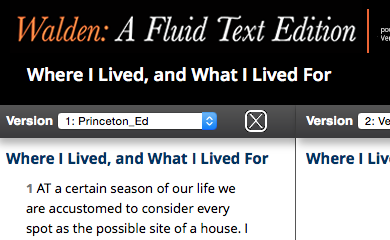
[See our update post on the Digital Thoreau blog too!]
A Recap: What is Walden: A Fluid Text?
 Our Fluid Text edition of Walden gathers eight years and seven versions of the American masterpiece using the Versioning Machine tool and Text Encoding Initiative (TEI) mark-up. Want the modern edit of the masterpiece?– we also have the 1971 Princeton University Press edition, reproduced with permission. Readers can see the definitive version foremost (with or without our notes, easily toggled off for a clean read), and then view the older workings of the novel. Easily presented side-by-side, readers can wade time’s river in order to view the evolution of Walden as Thoreau honed it over the years. We’ve encoded the textual changes down to the word based on the scholarship of Ron Clapper. A simple click on the text will highlight the cross-edition variations; all the grunt work has been done for the fascinated student of Thoreau, and now further opportunities for scholarship are available with this publicly available text. Coders, too, can step behind-the-screen to see our TEI mark-up and XSLT. The Fluid Text edition of Walden takes the confident and singular challenge Thoreau gave us long ago even further through the field of digital humanities, and studies of encoding and authorial evolution:
Our Fluid Text edition of Walden gathers eight years and seven versions of the American masterpiece using the Versioning Machine tool and Text Encoding Initiative (TEI) mark-up. Want the modern edit of the masterpiece?– we also have the 1971 Princeton University Press edition, reproduced with permission. Readers can see the definitive version foremost (with or without our notes, easily toggled off for a clean read), and then view the older workings of the novel. Easily presented side-by-side, readers can wade time’s river in order to view the evolution of Walden as Thoreau honed it over the years. We’ve encoded the textual changes down to the word based on the scholarship of Ron Clapper. A simple click on the text will highlight the cross-edition variations; all the grunt work has been done for the fascinated student of Thoreau, and now further opportunities for scholarship are available with this publicly available text. Coders, too, can step behind-the-screen to see our TEI mark-up and XSLT. The Fluid Text edition of Walden takes the confident and singular challenge Thoreau gave us long ago even further through the field of digital humanities, and studies of encoding and authorial evolution:
It is not all books that are as dull as their readers . . .
The Upgrade
With the release of the newly updated Walden: A Fluid Text comes plenty of detail, and quite a few major features. SUNY Geneseo’s Fluid Text team has worked primarily to clean up and edit the text, and to work on a new face for the project. Various bugs and textual errors reported by ours users have been amended, and we used this data to forecast how we wanted to improve the webpage for this update, and this is what we’ve done.
Our Walden: A Fluid Text Data Dictionary has been updated, so now TEI experts and novices alike can view the substratum of encoding mark-up– the usage of TEI elements and attributes, as well as definitions and further usage tips. On a similar note for coders and the curious, our XSLT source code is now available [zip, tar.gz].
Support for Thoreau’s journal notes (added by Dr. Paul Schacht’s “Literature and Literary Study in a Digital Age” course students) are now available in our work as Notes studded throughout the text. These journal notes were the earliest conceptions of many famous thoughts and passages found in Walden, jotted down by Thoreau years in advance. If you want to take a look at the student work and how this was done through scholarship and various coding methods for this semester-long undertaking, head over here.
In our polishing, we’ve also overhauled the graphical qualities of Walden: A Fluid Text. Stylistic textual rendering has been tweaked, and the distinctive tables in Economy, the inaugural and often mathematical chapter, are reformatted for easier understanding. Currently, individual columns in the versioning machine layout can now scroll independently of each other as well, so that reader’s can compare different sections of Walden at once.
What’s Next
 Our Fluid Text, as the name suggests, is always changing, and we have many more features in mind. In keeping with the possibilities of digital tools, and TEI in particular, we have a planned revamp of the website interface to gild our look with a simplicity inspired by Walden itself. Dr. Paul Schacht plans on involving students in this project through further work in his Digital Studies course. A new users manual is planned to accompany the new look. Special attention will also be paid to accessibility on tablet screens, for scholars who want to read Thoreau in the library and woods alike.
Our Fluid Text, as the name suggests, is always changing, and we have many more features in mind. In keeping with the possibilities of digital tools, and TEI in particular, we have a planned revamp of the website interface to gild our look with a simplicity inspired by Walden itself. Dr. Paul Schacht plans on involving students in this project through further work in his Digital Studies course. A new users manual is planned to accompany the new look. Special attention will also be paid to accessibility on tablet screens, for scholars who want to read Thoreau in the library and woods alike.
No wonder that Alexander carried the Illiad with him on his expeditions in a precious casket. A written word is the choicest of relics . . .

